
Bock is a strong German beer, usually a dark lager.

Wheat beer is a top-fermented beer which is brewed with a large proportion of wheat relative to the amount of malted barley. The two main varieties are German Weizenbier and Belgian witbier; other types include Lambic, Berliner Weisse, and Gose.
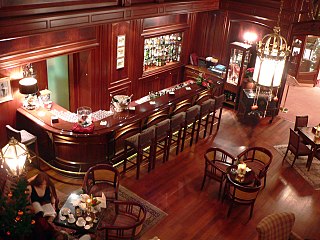
A bar, also known as a saloon, a tavern or tippling house, or sometimes as a pub or club, is a retail business that serves alcoholic beverages, such as beer, wine, liquor, cocktails, and other beverages such as mineral water and soft drinks. Bars often also sell snack foods, such as crisps or peanuts, for consumption on their premises. Some types of bars, such as pubs, may also serve food from a restaurant menu. The term "bar" refers to the countertop where drinks are prepared and served, and by extension to the overall premises.
The Reinheitsgebot is a series of regulations limiting the ingredients in beer in Germany and the states of the former Holy Roman Empire. The best known version of the law was adopted in Bavaria in 1516, but similar regulations predate the Bavarian order, and modern regulations also significantly differ from the 1516 Bavarian version. Although today the Reinheitsgebot is mentioned in various texts about the history of beer, historically it was only applied in the duchy, electorate, then Kingdom of Bavaria and from 1906 in Germany as a whole, and it had little or no effect in other countries or regions.
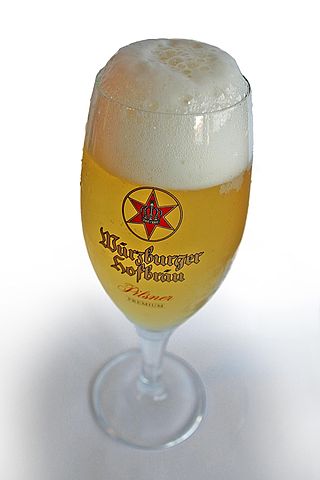
Pale lager is a pale-to-golden lager beer with a well-attenuated body and a varying degree of noble hop bitterness.
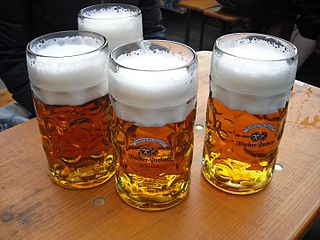
Märzen or Märzenbier is a lager that originated in Bavaria, Germany. It has a medium to full body and may vary in colour from pale through amber to dark brown. It was the beer traditionally served at the Munich Oktoberfest. The geographical indication Oktoberfestbier is protected in the EU and can only be used for Märzen that is brewed in Munich.

Helles or hell is a traditional German pale lager beer, produced chiefly in Southern Germany, particularly Munich. The German word hell can be translated as "bright", "light", or "pale".
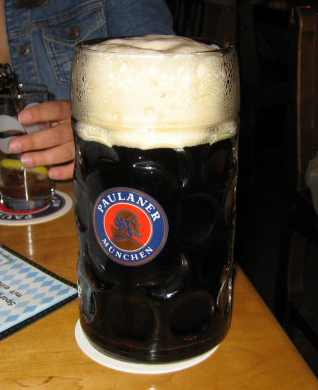
Dunkel, or Dunkles, is a word used for several types of dark German lager. Dunkel is the German word meaning "dark", and dunkel beers typically range in color from amber to dark reddish brown. They are characterized by their smooth, malty flavor. In informal terms, such as when ordering at a bar, "dunkel" is likely to mean whatever dark beer the bar has on tap, or sells most of; in much of north and western Germany, especially near Düsseldorf, this may be Altbier.

The Staatliches Hofbräuhaus in München is a brewery in Munich, Germany, owned by the Bavarian state government. The Hof (court) comes from the brewery's history as a royal brewery in the Kingdom of Bavaria. The brewery owns the Hofbräuhaus am Platzl, the Hofbräukeller and one of the largest tents at the Oktoberfest (Hofbräu-Festzelt).

A beer hall is a large pub that specializes in beer.
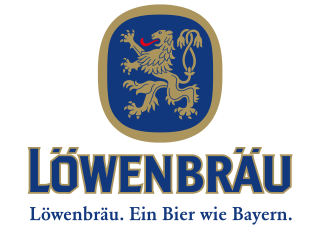
Löwenbräu is a brewery in Munich. Most of its beers are marketed as being brewed according to the Reinheitsgebot, the Bavarian beer purity regulation of 1516.

Beer is a major part of German culture. According the Reinheitsgebot, only water, hops, yeast and malt are permitted as ingredients in its production. Beers not exclusively using barley-malt, such as wheat beer, must be top-fermented.
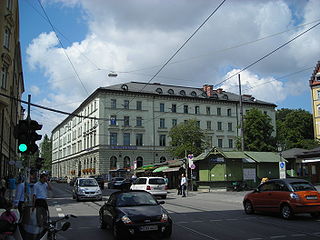
The Hofbräukeller is a restaurant in Haidhausen, Munich, Germany owned by Hofbräuhaus brewery. This restaurant serves the traditional Bavarian cuisine and is less touristy than Hofbräuhaus am Platzl and more popular with the locals. It is a part of the Wiener Platz, home to the Wiener Markt.
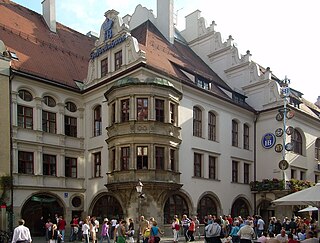
The Hofbräuhaus am Platzl is a beer hall in Munich, Bavaria, Germany, originally built in 1589 by Bavarian Duke Maximilian I as an extension of the Staatliches Hofbräuhaus in München brewery. The general public was admitted in 1828 by Ludwig I. The building was completely remodeled in 1897 by Max Littmann when the brewery moved to the suburbs. All of the rooms except the historic beer hall ("Schwemme") were destroyed in the World War II bombings. The reopening of the Festival Hall in 1958 marked the end of the post-war restoration work.
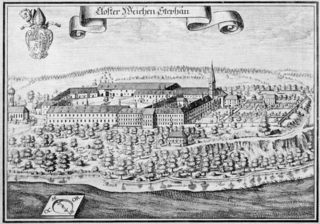
Weihenstephan Abbey was a Benedictine monastery in Weihenstephan, now part of the district of Freising, in Bavaria, Germany. Brauerei Weihenstephan, located at the monastery site since at least 1040, is said to be the world's oldest continuously operating brewery.

A drinking establishment is a business whose primary function is the serving of alcoholic beverages for consumption on the premises. Some establishments may also serve food, or have entertainment, but their main purpose is to serve alcoholic beverages. There are different types of drinking establishment ranging from seedy bars or nightclubs, sometimes termed "dive bars", to 5,000 seat beer halls and elegant places of entertainment for the elite. A public house, informally known as a "pub", is an establishment licensed to serve alcoholic drinks for consumption on the premises in countries and regions of British influence. Although the terms are increasingly used to refer to the same thing, there is a difference between pubs, bars, inns, taverns and lounges where alcohol is served commercially. A tavern or pot-house is, loosely, a place of business where people gather to drink alcoholic beverages and, more than likely, also be served food, though not licensed to put up guests. The word derives from the Latin taberna and the Greek ταβέρνα/taverna.

The Bayerische Staatsbrauerei Weihenstephan is a German brewery owned by the Free State of Bavaria located on the site of the former monastery Weihenstephan Abbey in Freising, Bavaria. In 2014, the total output was 403,039 hectolitres (343,457 US bbl). The brewery advertises itself as "The World's Oldest Brewery" although this is not historically verifiable.
Hofbräuhaus Traunstein is a beer brewery in Traunstein, southeastern Bavaria, Germany.

The Platzl is a public square in Munich, Germany, at which multiple notable buildings reside or resided, such as the Theater am Platzl and the Hofbräuhaus am Platzl.
Hofbräuhaus Columbus is a German brewery and restaurant in Grandview Heights, a suburban enclave of Columbus, Ohio.

























